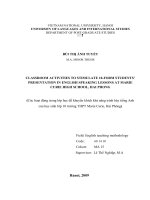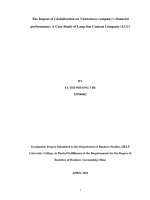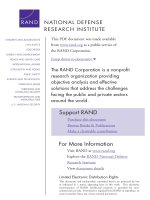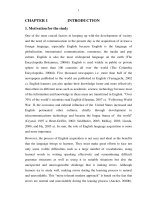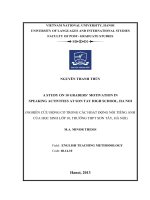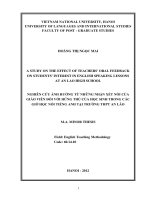Adapting speaking tasks in the textbook tieng anh 10 to improve the effectiveness of speaking lessons at thuong cat high school a case study
Bạn đang xem bản rút gọn của tài liệu. Xem và tải ngay bản đầy đủ của tài liệu tại đây (1 MB, 112 trang )
VIETNAM NATIONAL UNIVERSITY, HANOI UNIVERSITY OF
LANGUAGES AND INTERNATIONAL STUDIES FACULTY OF POSTGRADUATE STUDIES
NGUYỄN THỊ NHUNG
ADAPTING SPEAKING TASKS IN THE TEXTBOOK “TIENG
ANH 10” TO IMPROVE THE EFFECTIVENESS OF SPEAKING
LESSONS AT THUONG CAT HIGH SCHOOL: A CASE STUDY.
Điều chỉnh các nhiệm vụ nói trong sách giáo khoa Tiếng Anh 10
nhằm tăng hiệu quả các giờ dạy nói tại trường THPT Thượng Cát :
Một nghiên cứu điển hình.
M.A MINOR PROGRAMME THESIS
Field: English Teaching Methodology
Code: 60140111
HA NOI, 2016
VIETNAM NATIONAL UNIVERSITY, HANOI UNIVERSITY OF
LANGUAGES AND INTERNATIONAL STUDIES FACULTY OF POSTGRADUATE STUDIES
NGUYỄN THỊ NHUNG
ADAPTING SPEAKING TASKS IN THE TEXTBOOK “TIENG
ANH 10” TO IMPROVE THE EFFECTIVENESS OF SPEAKING
LESSONS AT THUONG CAT HIGH SCHOOL: A CASE STUDY.
Điều chỉnh các nhiệm vụ nói trong sách giáo khoa Tiếng Anh 10
nhằm tăng hiệu quả các giờ dạy nói tại trường THPT Thượng Cát :
Một nghiên cứu điển hình.
M.A MINOR PROGRAMME THESIS
Field: English Teaching Methodology
Code: 60140111
Supervisor: Prof. Nguyễn Hòa
HA NOI, 2016
DECLARATION
I hereby certify the thesis entitled “Adapting speaking tasks in the textbook
Tieng Anh 10 to improve the effectiveness of speaking lessons at Thuong Cat
High School: A case study.” as my own study in the fulfilment of the
requirements for the Degree of Master of Arts at the University of Languages
and International Studies, Vietnam National University, Hanoi.
Signature
Nguyễn Thị Nhung
i
ACKNOWLEDGEMENTS
I have benefited a great deal of support from a number of people during the time
carrying out this thesis.
I would like first and foremost to express my profound gratitude and appreciation to
my supervisor, Prof. Nguyễn Hòa for his invaluable and insightful comments, his
deliberate guidance and wholehearted supervision without which the thesis would
not have been possible.
My thanks are also offered to all my respected lecturers in the M.A course, Assoc.
Prof. Lê Hùng Tiến, Prof. Nguyễn Quang, Assoc. Dr. Lê Văn Canh, Assoc. Dr. Lâm
Quang Đông, Dr. Huỳnh Anh Tuấn…., for their informative and valuable lectures
that have enlightened my research path of the study.
Special acknowledgement is also given to my students from class 10D1 Thuong Cat
High School for their participation in the lessons. My appreciation is also extended
to my colleagues in the English Division of Thuong Cat High School for their
assistance and work sharing.
Last but not least, my heartfelt thanks go to my family and my close friends for
their understanding, love, and support.
ii
ABSTRACT
In the teaching context of Thuong Cat High School in Bac Tu Liem, Ha Noi, the
adaptation of speaking tasks in the textbook „Tieng Anh 10‟ is necessary because
teaching and learning speaking is not usually efficient. The students can hardly take
part in speaking tasks seriously though they have the desire to speak English. This
mini action research is conducted in order to investigate how adapted tasks help
students of low level to get more involved in speaking, as well as improve their
language accuracy and fluency. Oral tests together with survey questionnaire and
observations are the main instruments of data collection. They are delivered to 40
grade-10 students to collect individual scores, their opinions about speaking tasks in
the textbook and their behaviors while doing speaking tasks. Based on the data,
together with advantages in methodology, the speaking tasks are adapted and
speaking activities are implemented as pilot teaching is employed to realize the
objectives of the action research. The results indicate that most of the adapted tasks
bring about some clear improvement in the students‟ participation and their
language proficiency without omitting available textbook tasks. Finally, some
limitations of the study are discussed.
iii
LIST OF ABBREVIATIONS
ESL/ EFL: English as Second/ Foreign Language
MC: Master Of Ceremonies
T: Teacher
Ss: Students
Gv: Giáo viên
Hs: Học sinh
iv
LIST OF FIGURES AND TABLES
Table 1: The students‟ motivation in learning English speaking
Table 2+3: The students‟ opinions about English speaking skills in the textbook
Tieng Anh 10
Table 4: The students‟ general evaluation of their current speaking lessons
Table 5: The students‟ participation in speaking lessons.
Table 6: Factors prevent the students from participating in speaking in the class.
Table 7: The students‟ opinion about the way their teacher taught English speaking
Table 8: The students‟ evaluation of their teacher‟s task adaptation
Table 9: The students‟ scores in the Pre-test.
Table 10: The students‟ opinions about the vocabulary relating to the topics in the
speaking tasks
Table 11+12: The students‟ opinions about the topics of speaking tasks
Table 13+14: The students‟ opinions about the speaking tasks
Table 15: The students‟ response to the adapted tasks for Unit 14
Table 16: The students‟ response to the adapted tasks for Unit 16
Table 17: The students‟ scores in Post-test after Unit 12
Table 18: The students‟ scores in Post-test after Unit 16
Figure 1: The students‟ motivation in learning English speaking
v
Figure 2: The students‟ opinions about the textbook‟s topics in the textbook Tieng
Anh 10
Figure 3: The students‟ opinions about the textbook‟s speaking activities in the
textbook Tieng Anh 10
Figure 4: The students‟ general evaluation of their current speaking lessons
Figure 5: The students‟ participation in speaking lessons.
Figure 6: : Factors prevented the students from participating in speaking in the
class.
Figure 7: The students‟ opinion about the way their teachers taught speaking
Figure 8: The students‟ evaluation of their teacher‟s adaptation
Figure 9: The students‟ scores in the Pre-test.
Figure 10: The students‟ opinions about the vocabulary relating to the topics in the
speaking tasks
Figure 11: The students‟ opinions about the topic‟s familiarity of the speaking tasks
Figure 13: The students‟ opinions about the speaking tasks‟ ease
Figure 14: The students‟ opinions about the speaking tasks‟ interesting organization
Figure 15: The students‟ response to the adapted tasks for Unit 14
Figure 16: The students‟ response to the adapted tasks for Unit 16
Figure 17: The students‟ scores in the Post-test after Unit 12
Figure 18: The students‟ scores in the Post-test after Unit 16
vi
TABLE OF CONTENTS
DECLARATION .......................................................................................................
ACKNOWLEDGEMENTS .....................................................................................
ABSTRACT .............................................................................................................
LIST OF ABBREVIATIONS.................................................................................
LIST OF FIGURES AND TABLES ........................................................................
TABLE OF CONTENTS .......................................................................................
PART I: INTRODUCTION .....................................................................................
1.
Rationale for the study..........................................................................................
2.
Aims of the study ...................................................................................................
3.
Research questions ................................................................................................
4.
Scope of the study .................................................................................................
5.
Methods of the study .............................................................................................
6.
Design of the study ...............................................................................................
PART II: DEVELOPMENT ....................................................................................
CHAPTER 1. LITERATURE REVIEW ................................................................
1.1. The teaching of speaking ................................................................................
1.1.1.1. The role of spoken English .......................................................................
1.1.1.2. Nature of spoken discourse .......................................................................
1.1.1.3.
Functions of speaking ........
1.1.1.4.
Implications for teaching ...
b.
Talk as transaction .............................................................................................
1.1.2. Related factors affecting students‟ speaking .............................................
1.1.2.1.
Context ................................
vii
1.1.2.2.
Teachers................................................................................................. 10
1.1.2.3.
Learners................................................................................................. 10
1.1.2.4.
Materials................................................................................................ 11
1.2. Tasks and task adaptation........................................................................... 11
1.2.1.
Tasks in FL/SL learning and teaching.................................................... 12
1.2.2.
Task adaptation in FL/SL learning and teaching................................... 12
1.2.2.1.
The need of task adaptation................................................................... 12
1.2.2.2.
What is adaptation?............................................................................... 12
1.2.2.3.
Reasons for adaptation.......................................................................... 13
1.2.2.4.
Approaches to task adaptation............................................................... 14
1.3. Summary...................................................................................................... 16
CHAPTER 2. RESEARCH METHODS............................................................. 17
2.1. The case of the study...................................................................................... 17
2.1.1. Setting of the study....................................................................................... 17
2.1.2. The learners.................................................................................................. 17
2.1.3. Speaking materials....................................................................................... 18
2.2. An action research.......................................................................................... 18
2.2.1. Applied steps................................................................................................. 18
2.2.2. The adaptation of speaking tasks in Tieng Anh 10...................................... 20
2.3. Instrumentation and Procedures................................................................... 27
2.3.1. Instrument 1: Preliminary Survey............................................................. 28
2.3.2. Instrument 2: Oral tests.............................................................................. 29
2.3.3. Instrument 3: Survey Questionnaire.......................................................... 29
2.3.4. Instrument 4: Survey for Response to Adaptation.................................... 29
viii
2.3.5. Instrument 5: Class Observation Sheets.................................................... 30
CHAPTER 3: DATA ANALYSIS......................................................................... 31
3.1. Data analysis of Preliminary Survey (See Appendix 1)...............................31
3.1.1. Personal information of the students‟ taking part in the survey.............31
3.1.2. The students‟ awareness of studying English in general..........................31
3.1.3. The students‟ opinions about English speaking skills in the textbook
Tieng Anh 10.......................................................................................................... 33
3.1.4. The students‟ evaluation of their current speaking lessons.....................34
3.1.4.1. The students‟ general evaluation of their current speaking lessons.....34
3.1.4.2. The students‟ participation in speaking lessons and the reasons.........35
3.1.4.3. The students‟ opinions about the way their teachers taught English
speaking................................................................................................................. 38
3.2. Data analysis from initial observations (see appendix 5).............................39
3.3. Data analysis of Pre-tests (see Appendix 2).................................................. 43
3.4. Data analysis of Survey Questionnaire (see Appendix 3)............................44
3.4.1. In terms of language (vocabulary)............................................................. 44
3.4.2. In terms of topic........................................................................................... 45
3.4.3. In terms of speaking tasks.......................................................................... 47
3.4.4. The students‟ suggestions for the teacher‟s adaptation of speaking tasks
49
3.5. Data analysis of Survey for response to adaptation (see Appendix 4)........49
3.5.1. Data analysis of response to task adaptation of Unit 14, delivered on
th
April 17 , 2015. (Number of participants: 40)....................................................... 50
3.5.2. Data analysis of response to task adaptation of Unit 16, delivered on May
th
14 , 2015. (Number of participants: 40)................................................................. 52
ix
3.6. Data analysis from while-observation:......................................................... 53
3.6.1. While-observation ( See Appendix 5)......................................................... 53
3.6.2. Reflection on the adaptation....................................................................... 53
3.7. Data analysis from Post-tests......................................................................... 56
3.7.1. Post-test after Unit12................................................................................... 56
3.7.2. Post-test after Unit 16.................................................................................. 57
PART III: CONCLUSION................................................................................... 58
1. Recapitulation.................................................................................................... 58
2. Major findings and conclusion......................................................................... 58
3. Limitations of the study:................................................................................... 59
REFERENCES...................................................................................................... 60
APPENDIX 1
................................................................................................................................
III
x
PART I: INTRODUCTION
1. Rationale for the study
In the past ten years, teaching English speaking at school has earned a lot of
attention and investment from both experts and teachers as well as learners and their
communities. The three main reasons must be: first, the key practical role of English
speaking has received the social awareness; second, modern information technology
has brought learners an easy access to native speakers‟ talks; third, many
methodology courses sponsored by the government have helped teachers to
approach some new teaching methods. As a result, students‟ speaking ability has
improved much in general.
Despite all of the above advantages, I see no much progress in the class I teach at
Thuong Cat High School. By observing, I notice most of my students hesitate to
participate in English speaking tasks. Even as the teachers have managed to engage
them in, their talks show some problems of using accurate and fluent language.
Some researchers have been particularly interested in the same situation in teaching
English skills and tried to improve it by adaptation (Phùng Thị Hoa Mơ, 2010;
Nguyễn Thị Trang, 2012). However, most of them conclude that poor textbooks and
students‟ low motivation are the main reasons. Whereas the students in my class of
10D1 confirm that they want to speak English much more than reading, writing,
grammar, and they find almost all the topics interesting. Moreover, the new set of
textbooks do have several strong points, which are available task-based contexts and
carefully guided communication practice.
Considering their English scores at the beginning of the course, I realize that most
of my students are of low level, some are better but no one is excellent. Therefore, I
do a preliminary research, search the Internet and read ESL/EFL studies. I find that
spoken discourse has its own characteristics and, thus, the teaching must be
1
distinctive. I wonder if I can help them by providing them with more language input
together with knowledge background, and by adapting some speaking tasks in the
textbook „Tiếng Anh 10‟. I do hope that these changes will help them to have such
achievements as participating more in speaking activities and producing somewhat
more accurate and fluent language.
All of these above have inspired me to conduct the study titled “Adapting speaking
tasks in the textbook Tieng Anh 10 to improve the effectiveness of speaking lessons
at Thuong Cat High School: A case study.”
2. Aims of the study
The study is aimed at improving the effectiveness of English speaking lessons for
th
the 10 grade students at Thuong Cat High School by means of the adaptation of
speaking tasks in the textbook „Tieng Anh 10‟.
3. Research questions
In order to achieve the mentioned aim, the following research question guided the
study:
To what extent can the adapted tasks help improve the effectiveness of
speaking lessons?
4. Scope of the study
Task adaptation is such a broad topic that it cannot be wholly discussed within the
framework of this paper; therefore, only one specific aspect will be central to the
speaking tasks‟ adaptation.
The study focuses on only one class of grade-10 students, so the results of the study
are not applied to all students at Thuong Cat High School or ones at other high
school.
2
5. Methods of the study
First, the study titled “Adapting speaking tasks in the textbook Tieng Anh 10 to
improve the effectiveness of speaking lessons at Thuong Cat High School.” is a case
study. It is conducted in class 10D1 at Thuong Cat High School in Bac Tu Liem,
Hanoi City. 40 students of class 10D1 are all at the age of 17. All of them have
learnt English since they were at grade 3, but most of them are low-level English
speakers. Though they pay much attention to study English, their English is not very
good in general and their speaking ability is of low level in particular.
Second, the study is an action research. According to Nunan (1992: 19), an action
research includes seven steps. They are: initiation, preliminary investigation,
hypothesis, intervention, evaluation, dissemination and follow-up. Details of these
steps will be presented in chapter 2 of Part II.
The action research lasts during the second term from Unit 9 to Unit 16. It is about
18 weeks. Oral tests together with survey questionnaire and observations are the
main instruments of data collection. They are delivered to 40 grade-10 students to
collect individual scores, their opinions about speaking tasks in the textbook and
their behaviors while doing speaking tasks.
Based on the data, together with advantages in methodology, the speaking tasks are
adapted and speaking activities are implemented as pilot teaching is employed to
realize the objectives of the action research. Two approaches to adaptation that
guide this research are making accuracy-based practice meaningful and adapting
fluency-based activities, Hedge (2000: 273- 281).
6. Design of the study
The study consists of three main parts namely Introduction, Development and
Conclusion.
3
In the first part, Introduction, the reasons for the research, aims, research
questions, scope and methods of the study are mentioned.
The second part, Development, contains three chapters:
- Chapter One focuses on theoretical background of the study, which is about
features, and functions of spoken discourse, implications for teaching, and purposes
as well as two main approaches of adaptations: accuracy-based practice and
fluency-based activities.
- Chapter Two not only describes the case of the study at Thuong Cat High School
but also presents the applied steps of an action research in details and the
instrumentation of the study.
- Chapter Three deals with a comprehensive data analysis.
The last part, Conclusion, provides the recapitulation, major findings and
limitations of the study.
4
PART II: DEVELOPMENT
CHAPTER 1. LITERATURE REVIEW
1.1.
The teaching of speaking
In order to help students to develop their English speaking ability we need insights
about the nature of spoken discourse, so we will be able to find a useful
methodology to select and design appropriate classroom activities.
1.1.1. Speaking
1.1.1.1.
The role of spoken English
The mastery of English speaking skills plays a very important role for many foreign
language learners. Consequently, learners tend to evaluate their success in language
learning as well as the effectiveness of their English lessons basing on how well
they feel they have improved in their speaking ability or proficiency.
In addition, teachers and textbooks make use of a variety of approaches in the
teaching of oral skills, which shows that “ oral skills have hardly been neglected in
EFL/ESL courses” . Therefore, it is observed that “ how best to approach the
teaching of oral skills has long been the focus of methodological debate”, Richards
(2009:21).
Reflecting on the textbook Tieng Anh 10, I think teachers can take a great deal of
advantages in methodology.
1.1.1.2.
Nature of spoken discourse
According to McCarthy and Carter, 1997 (cited in Richards, 2009:21), it is recent
advances in discourse analysis that have revealed the nature of spoken discourse and
its differences from written discourse. Luoma, 2004 (cited in Richards, 2009:22)
points out some of the following features of spoken discourse:
5
Conjoined short phrases and clauses
May be planned or unplanned
Employs more vague or generic words than written language
Employs fixed phrases, fillers and hesitation markers
Contains slips and errors reflecting on-line processing
Interactions are jointly constructed
Shows variation, reflecting speaker roles, speaking purpose, and the
context
Among them, I pay much attention to the two following features:
First, “spoken discourse is usually unplanned and often reflects the processes of
constructions”, Richards (2009:2). Thus, errors must be carefully chosen to be
treated in order that the correction does not ruin fluency. In my opinion, errors that
impede communication should be directly corrected. Tricia Hedge (2000:289) gives
an example of such error: “ They ate smoked worm” is not immediately apparent as
“They ate smoked eel”, and “long trees” can be misunderstood as “tall trees”.
Besides, the assessment of fluency should be much more flexible, which will be
discussed in detail in the part of adaptation.
Second, “interactions are jointly constructed”, which asks for shared background,
active and intelligibility participation. It implies that in addition to fluency, accuracy
must be put in consideration and speaking activities must be well designed so that
engaging students in can be successful. Moreover, the topic of speaking tasks in
textbooks should be familiar to students, or else some preparation must be made
before each lesson.
1.1.1.3.
Functions of speaking
Richards uses a three-part framework, which is expanded from Brown and Yule‟s
one, to classify the interaction functions of speaking: talk as interaction, talk as
6
transaction, and talk as performance. Their forms and functions are quite different
and therefore they require different teaching approaches.
a. Talk as interaction
This refers to “conversation” which serves as primarily social function. The focus is
more on speaker‟s wish to present themselves other than on the message. Brown
and Yule, 1983 (cited in Richards, 2009:25) describe its main features as follows:
Has a primarily social function
Is jointly constructed
b. Talk as transaction
The focus of this kind of talk is on what is said or done. The message and making
oneself understood clearly and accurately are focused on rather than the participants
and their interacting manner.
Some main features are given by Richards (2009:29):
It has a primarily information focus
Linguistic accuracy is not always important
c. Talk as performance
This type of talk refers to public talk transmitting information in front of an
audience. According to Richards (2009:32), the main features of talks as
performance are:
It reflects predictable organization and sequencing
Form and accuracy is important
1.1.1.4.
Implications for teaching
a. Talk as interaction
Though mastering such skills is difficult and may not be the most important to most
7
students at school, I think they should practice a wide range of topics to present
good images of themselves in situations which call for interaction talks.
Two simple activities Richards uses to practice topic management are “in the hot
seat” and “question time”. In the first activity, a student sits on a chair in front of the
class and makes a statement about something he or she did recently. The other
members of the class have to ask three or more questions about the topic which the
student has to answer quickly. Then another student takes the hot seat. With the
activity called question time, before students begin a lesson on a new theme, he
prepares up to 15 questions related to the theme and put them on a handout. First, he
asks students around the class to answer the questions quickly. Then students
practice asking and answering the questions in pairs.
b. Talk as transaction
In terms of the level of linguistic accuracy that students achieve when carrying out
tasks as transaction, some scholars like Thornbury,1998 and Kumaravadivelu,1991
state that practicing these tasks focuses on task accomplishment rather than
grammatical practice and a gradual modification of their language output over time
takes on more and more target-like forms. However, Higgs and Clifford, 1982 (cited
in Richards 2009:37) claim that communication tasks often develop fluency at the
expense of accuracy. Richards (2009:39) recognizes that low-level students often
heavily rely on vocabulary and memorized chunks of language while carrying out
communication tasks. Therefore, to improve the quality (accuracy and fluency) of
language produced as students practice, he suggests:
Pre-teaching certain linguistic forms
Reducing the complexity of the task
Giving time to plan the task
Repeating performance of the task
c. Talk as performance
8
According to Johns,1996 (cited in Richards, 2009:42), teaching this type of talk
requires a different teaching strategy which involves providing examples or models
of speeches, oral presentation, stories,etc through video or audio recordings or
written examples. Guiding questions are:
What is the speaker‟s purpose?
Who is the audience?
What kind of information does the audience expect?
How does the talk begin, develop, and end? What moves or stages are
involved?
Is any special language used?
1.1.2. Related factors affecting students‟ speaking
Students‟ participation in classroom speaking activities and their English output can
be affected by a variety of factors originating from context, learners, teachers,
materials and classroom activities. In the following sections, some of the major
factors will be discussed.
1.1.2.1.
Context
Most of factors are “ outside the teacher‟s control but they will bear heavily on
decisions about choice of resources and classroom procedure” (Hedge, 2000:24).
She mentions the following factors:
Social attitudes
Social attitudes towards English learning partly determine teachers‟ effort to
motivate students and exposure to the language as well.
Educational system
Whether educational system provides potential or constraint depends on:
9
-
The extent to which the materials in use train for public examinations
-
The hours available for teaching
-
The existence of institutional or departmental policies
-
The physical constraints of the classroom
-
Class size
-
The resources available
-
The cohesion that exists among English language teachers
-
The status of teachers in the hierarchy
-
The financial/contractual status of teachers
-
The interest of management in continuing professional development
Examination system
Examination system is a heavily constraining factor where examinations are
considered gatekeepers to higher education or good jobs. Teachers would be of high
risk not to train students for these.
1.1.2.2.
Teachers
Harmer, 1991 (cited in Hedge, 2000:26) identifies teachers‟ roles “as controller in
eliciting nationality words; as assessor of accuracy; as corrector of pronunciation;
as organizer in giving instructions for the pair work, initiating it, monitoring it, and
organizing feedback; as prompter while students are working together; and as
resource if students need help”. All of these are common to a wide range of
classroom methods. Hedge (2000: 22-31) says that they can be seen in lesson plans
but only the ability to manage activities and interactions can put them in practice.
Only when teachers have competence in management of interaction can the
mentioned roles create beneficial conditions for language learning.
1.1.2.3.
Learners
Individual differences exist and play a significant role in language learning.
10
However, they are just the useful distinctions to classify them in order to have some
possible implications for teaching. Because there are not “certain attitudes,
personality characteristics, emotional disposition, and learning strategies that
somehow create the generically „good language learner‟” (Hedge, 2000:24).
In addition to individual differences, students in Thuong Cat High School share
some common characteristics that affect their learning in general and speaking in
particular. They are of low-level, which leads to limitations in language output
(accuracy and fluency) and anxiety (participation).
1.1.2.4.
Materials
O‟Neill, 1982 (cited in Hedge, 2000:36) outlines the benefits of textbook materials:
“they can offer a grammatical and functional framework which provides for the
common needs of a group of learners; they allow students to prepare in advance;
they provide quality of presentation, and they do not necessarily prevent a creative
spinning-off in the classroom into all kinds of other activities.” Because of all the
factors of teachers and learners mentioned above, textbooks should be learning
guides for students, and “good teachers have always taken a positively critical
approach to appraising and developing their work”.
1.2.
Tasks and task adaptation
No course book will be totally suited to a particular teaching situation. The teacher
will have to find his own way of using it and adapting it if necessary. So we should
not be looking for the perfect course book which meets all our requirement, but
rather for the best possible fit between what the course book offers and what we as
teachers and students need. Two approaches that guide this research are making
accuracy-based practice meaningful and adapting fluency-based activities, Hedge
(2000: 273- 281)
11
1.2.1. Tasks in FL/SL learning and teaching
Many linguists argue whether tasks can involve learners in working with particular
kinds of language. Brumfit, 1984a (cited in Carter and Nunan, 2001:19) stresses that
students should be provided the freedom to improve in fluency activities. Skehan,
1998 (cited in Carter and Nunan, 2001:19) believes that tasks can only provide
conditions for influencing the level of learners‟ complexity, accuracy or fluency. In
contrast, Loschky and Bley-Vroman, 1993 (cited in Carter and Nunan, 2001:19)
argue that tasks can target language features. Therefore, Carter and Nunan (2001:19)
state that the key question is how tasks operate and how to make tasks operate
effectively within classroom contexts.
1.2.2. Task adaptation in FL/SL learning and teaching
1.2.2.1.
The need of task adaptation
No certain set of activities can ensure that different groups of students practice the
speaking and problems can be found around the activities. Hedge (2000:281-283)
believes that whenever a problem occurs, which leads to students‟ failure, they can
feel frustrated to perform and they do not behave in them as the activities suggest
they should. This usually obstacles the possible contributions to speaking activities
and presents limitations to the development of English speaking ability. It suggests
to us the need to create range and variety in language activities to adapt to the
teaching and learning context.
1.2.2.2.
What is adaptation?
According to Tomlinson (1998: xi), adaptation is “making changes to materials in
order to improve them suitable for a particular type of learner.” In the aspect of
adaptation techniques, Madsen and Bowen (1978: ix-xi) mention adaptation as the
action of employing “one or more of a number of techniques: supplementing,
editing, expanding, personalizing, simplifying, modernizing, localizing, or
12
modifying cultural/ situational content.” Differently, Stevick (1972), cited in Mc
Donough and Shaw (1993: 83) emphasizes teachers‟ role of bridging a gap between
materials and learners: “the teacher must satisfy the demand of the textbook, but in
ways that will be satisfying to those who learn from it.”
In brief, adaptation requires teachers to change and revise materials to make them
more accessible to the teaching context.
1.2.2.3.
Reasons for adaptation
There are always some practical reasons for adapting materials in order to make them
as accessible and useful to learners as possible. However, reasons for adaptation have
varied and changed as the field has developed and views on language acquisition and
teaching practice have become better informed by research and experience. There are
two most frequently cited purposes for adaptation:
First, to make the material more suitable for the circumstances in which it is being
used, i.e. to mould it to the needs and interests of learners, the teachers‟ own
capabilities and such constraints as time, or as Mc Donough and Shaw (1993:85)
put it: “to maximize the appropriateness of teaching materials in context, by
changing some of the internal characteristics of a course book to better suit our
particular circumstances”
Second, to compensate for any intrinsic deficiencies in the materials, such as
linguistic inaccuracy, out-of-datedness, lack of authenticity (Madsen and Bowen
1978) or lack of variety.
Looking deeper into McDonough and Shaw‟s definition of purpose it can be seen
that maximizing the appropriateness of teaching materials (by, e.g., modifying them
in such a way that they seem more relevant to learners‟ interests and needs) is
important because when teachers make changes to a course book “to better suit our
particular purposes” what teachers are really trying to do is to improve students‟
13
